

ECMWF scientists made a big contribution to the EGU General Assembly 2021, held online from 19 to 30 April.
The presentations they delivered touched on many aspects of weather prediction as well as work done by the EU Copernicus services on climate change and atmospheric composition run by ECMWF.
There was some regret about proceedings being entirely online this year because of the COVID-19 pandemic. There was, however, praise for the breakout room structure, which made it possible to have discussions with the authors of presentations.
Earth system modelling
A top research priority is a reduction in the number of digits from double precision to single precision, as has just been implemented in ECMWF’s Integrated Forecasting System (IFS), and potentially further to half precision, to save computing power.
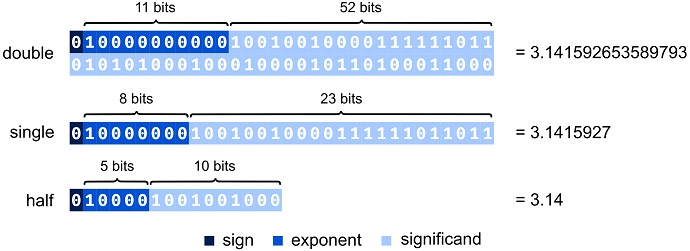
A representation of π in double, single and half precision.
Sam Hatfield gave an overview of developments at ECMWF towards fully single-precision coupled forecasts, with a discussion of the operational implementation of single precision in the atmosphere and ongoing work on the ocean model NEMO.
He also motivated an investigation into the use of half precision for select model components of the IFS.
Souhail Boussetta presented the latest research on land surface effects in the IFS. This included an update on plans to increase the number of soil layers to improve forecasts.
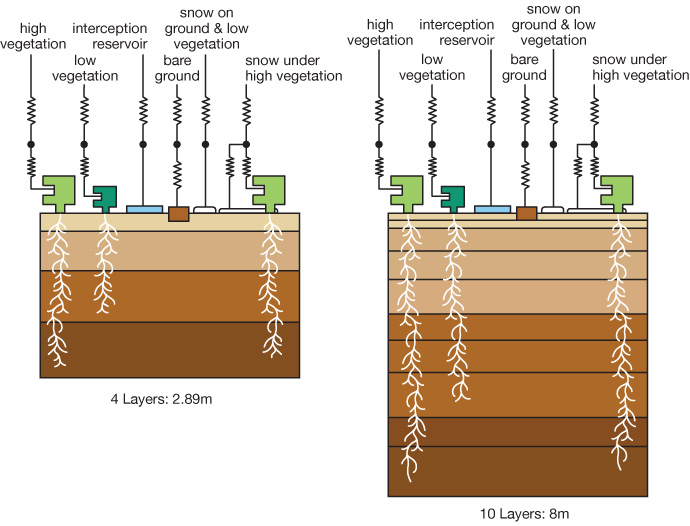
A 10-layer soil is expected to lead to better interaction with the atmosphere.
Matthew Chantry discussed work on using machine learning within the IFS. His project showed that the non-orographic gravity wave drag parametrization scheme can be emulated with a neural network while maintaining forecast accuracy.

Visualisation of the equatorial zonal jet in the existing physics scheme and a neural network emulator.
Martin Leutbecher gave a talk on progress in ensemble forecasting and verification methodologies at ECMWF. With Hannah Christensen (Oxford University) and Cecile Penland (NOAA/ESRL, PSD), he also gave a Short Course on stochastic parametrization aimed at PhD students, early-career scientists, and all those interested in an overview.
Thomas Rackow (AWI) presented an ongoing collaboration between ECMWF and the Alfred Wegener Institute, Helmholtz Centre for Polar and Marine Research. A recent development is a single-executable coupled configuration of the IFS and the Finite Volume Sea Ice-Ocean Model, FESOM2.
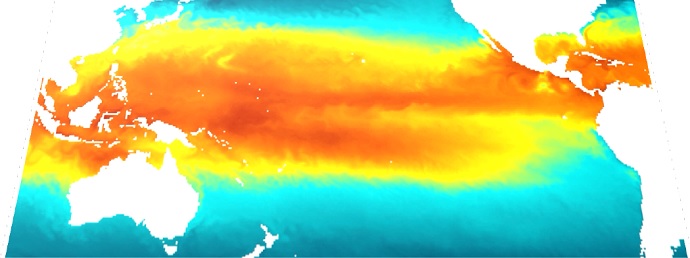
Tropical cyclone tracks as simulated by IFS-FESOM2 (IFS at about 4.5 km global resolution on average) are seen in the simulated FESOM2 sea-surface temperatures (ORCA025-analog grid).
IFS-FESOM2 and ECMWF’s default configuration IFS-NEMO are tentative models to generate ‘Digital Twin’ storm-scale, coupled simulations as envisioned in the EU’s Destination Earth (DestinE) and Next Generation Earth Modelling Systems (NextGEMS) projects.
Earth system predictability
Antje Weisheimer presented the latest thinking on how confident predictability estimates of the winter North Atlantic Oscillation (NAO) are.
In one of the event’s longer talks, she looked at 110-year-long historical hindcasts over the period 1901–2010 performed with ECMWF’s coupled model. Her findings are that relatively short hindcasts are not sufficiently representative for longer-term behaviour and can lead to skill estimates that may not be robust in the future.

A schematic representation of an ideal forecast and a realistic forecast of the North Atlantic Oscillation.
Chris Roberts presented research on the impact of North Atlantic sea-surface temperature (SST) on errors in sub-seasonal forecasts. He found that correcting errors in the position of the Gulf Stream improves the atmospheric mean state and the simulation of circulation anomalies in ECMWF forecasts.
The results demonstrate the potential benefits of higher-resolution ocean models that can better resolve the position of the Gulf Stream.

Impact of SST bias correction on forecast skill of meridional wind at 200 hPa. Changes in the continuous ranked probability skill score (CRPSS; shading) and anomaly correlation (grey contour spacing of 0.1) are shown for weekly mean anomalies derived from forecast days 26 to 32.
Earth system assimilation
Marcin Chrust gave a presentation on correcting model error with an online artificial neural network. He showed how model error can be learnt and applied in a weak constraint 4D-Var data assimilation framework as a model tendency forcing term.
Hao Zuo introduced the new ECMWF ocean and sea-ice reanalysis pilot system (ORAP6), which will be the foundation of ECMWF’s next operational system, OCEAN6. Evaluation results suggest that ocean and sea-ice states are improved in ORAP6 with respect to its predecessor ORAS5, largely due to its more realistic large-scale overturning circulations.

Twelve-month running mean of volume transports across the Florida Straight, verified against cable measurements.
Angela Benedetti presented the results of an ESA-funded study into using visible radiance data from satellites to estimate the concentration of aerosols. Many of the tools developed could be adapted to clouds, which could open the way towards a fuller exploitation of visible radiances to improve numerical weather prediction.
The left-hand plot shows total aerosol optical depth (AOD) at 550 nm in ECMWF’s analysis for 12 UTC on 1 March 2017 without the assimilation of aerosol information; the middle plot shows the same with the assimilation of reflectances from the MODIS instrument at two different wavelengths (670 nm and 866 nm); and the right-hand plot shows total AOD at 550 nm from MODIS for 1 March 2017.
Forecasting
Nikolaos Mastrantonas and his collaborators assessed if and where large-scale patterns over the Mediterranean can be used as predictors for forecasting localised extreme precipitation.
Results show that these patterns can indeed provide useful information about localised extremes in most locations with lead times of more than seven days.

Forecast limit (in days) up to when the ECMWF model outperforms climatology in predicting extreme precipitation, when indirectly predicting extremes using nine Mediterranean patterns.
Chloe Brimicombe used the Universal Thermal Climate Index (UTCI) from the ERA5-HEAT dataset to show that heat stress has been growing in area in August since 2000. This research also shows that the impacts of heat are underreported, including in meteorological organisation reports.
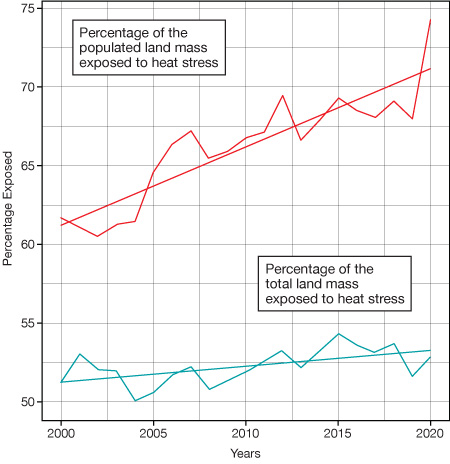
Since 2000, a growing percentage of populated land mass has been exposed to heat stress.
Copernicus
In the summers of 2019 and 2020, the Copernicus Atmosphere Monitoring Service (CAMS) closely monitored the development of large-scale wildfires in the Arctic Circle. It provides a wide range of information that can be used to better understand hydro-meteo-climatological conditions leading to these fires and their subsequent impact on the atmosphere.
At the EGU, Mark Parrington and colleagues presented an overview of climate change anomalies, fire weather forecasts and monitoring of fire emissions and air quality to give context to these events.
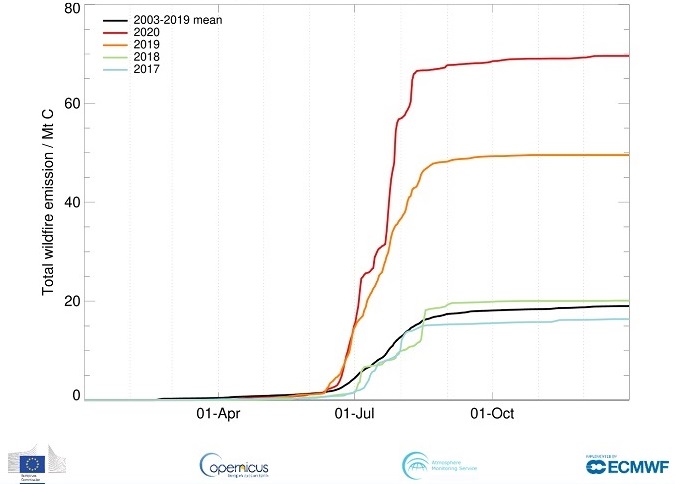
Cumulative estimated wildfire carbon emissions for the Arctic Circle throughout the year, highlighting sharp increases in 2019 and 2020 compared to previous years in the CAMS Global Fire Assimilation (GFAS) dataset.
Last but not least, Julien Nicolas, Francesca Guglielmo and David Lavers provided an overview of the Copernicus European State of the Climate report for 2020, released on 22 April, to the EGU. They presented the Copernicus Climate Change Service (C3S) report's main findings from across Europe and the Arctic.
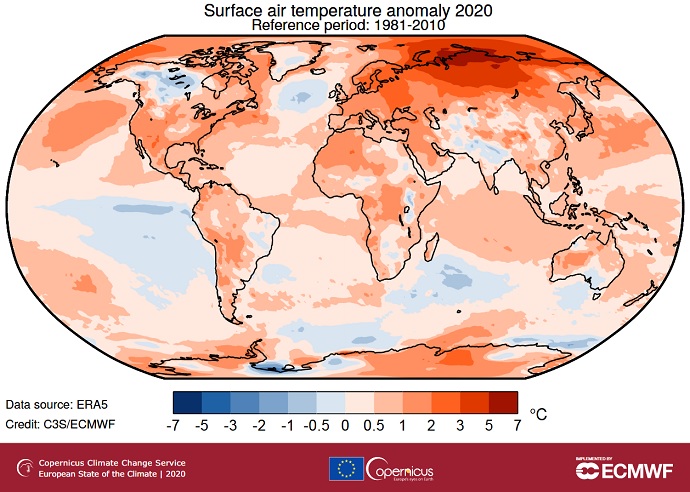
Surface air temperature for 2020, shown relative to the 1981–2010 average. Data source: ERA5 reanalysis. Credit: C3S/ECMWF.
